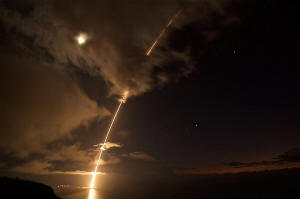Arms race gathers pace as Russia and US plan to redeploy once-banned
weapons
 Send a link to a friend
Send a link to a friend
 [July 17, 2024]
By Mark Trevelyan [July 17, 2024]
By Mark Trevelyan
LONDON (Reuters) - Four decades ago, the United States deployed cruise
and Pershing II nuclear missiles in Europe to counter Soviet SS-20s - a
move that stoked Cold War tensions but led within years to a historic
disarmament deal.
"We can be proud of planting this sapling, which may one day grow into a
mighty tree of peace," Soviet leader Mikhail Gorbachev told U.S.
President Ronald Reagan in December 1987 as they agreed to dismantle the
rival systems under a treaty that scrapped all ground-based
shorter-range and intermediate-range (INF) nuclear and conventional
weapons - those with ranges between 500 km and 5,500 km.
The sapling survived until 2019 when Donald Trump, then U.S. president,
quit the treaty, citing alleged violations that Russia denied. But the
risky implications of the pact's full unravelling are becoming fully
apparent only now, as both sides set out their plans for new
deployments.
On June 28, President Vladimir Putin said publicly that Russia would
resume producing short and intermediate-range land-based missiles -
something the West suspects it was already doing anyway - and take
decisions on where to place them if needed. Security experts assume
these missiles, like most Russian systems, will be capable of carrying
either conventional or nuclear warheads.
On July 10, the United States said it will start deployment in Germany
from 2026 of weapons that will include SM-6s and Tomahawks, previously
placed mainly on ships, and new hypersonic missiles. These are
conventional systems but some could also, in theory, be fitted with
nuclear tips, and security experts said Russian planning would have to
allow for that possibility.

The decisions, taken against the background of acute tensions over
Russia's war in Ukraine and what the West sees as threatening nuclear
rhetoric from Putin, add to an already complex array of threats for both
sides. They also form part of a wider INF arms race with China.
"The reality is that both Russia and the United States are taking steps
that they believe enhance their security, regardless of whether it comes
at the expense of the other," said Jon Wolfsthal, director of global
risk at the Federation of American Scientists.
"And as a result, every move that the United States or Russia make puts
pressure on the adversary to respond in some way, politically or
military. That's the definition of an arms race," Wolfsthal, a former
U.S. arms control official, said in a telephone interview.
STRIKE SCENARIOS
Andrey Baklitskiy, senior researcher at the United Nations Institute for
Disarmament Research, said the planned deployments created "more
scenarios for direct military confrontation between Russia and NATO
countries" for which all sides needed to prepare.
Hypothetically, he said, these could include eventualities such as a
Russian strike on a Polish base where Western weapons bound for Ukraine
were being stored, or a U.S. attack on a Russian radar or a command and
control post.
He said each side already has the capability to carry out such strikes
using sea- or air-launched missiles, but adding ground-based weapons
would give them more options to conduct an attack and withstand the
enemy's response.
[to top of second column]
|

A medium-range ballistic missile target is launched from the Pacific
Missile Range Facility, before being successfully intercepted by
Standard Missile-6 missiles fired from the guided-missile destroyer
USS John Paul Jones, in Kauai, Hawaii, U.S. August 29, 2017 in this
handout image. Latonja Martin/U.S. Navy/Handout via REUTERS/File
Photo

The risk, the experts said, is that this fuels already-high tensions
and prompts a further spiral of escalation.
Wolfsthal said he saw the planned U.S. deployments in Germany as a
signal of reassurance to European allies rather than a step
conferring any significant military advantage.
"My only concern about the deployment of these systems is they may
not really add to our military capability but they almost certainly
add to the risk that a crisis could accelerate and grow out of
control," he said.
Ulrich Kuehn, an arms control specialist at the Institute for Peace
Research and Security Policy in Hamburg, said in a telephone
interview: "From a Russian perspective, if you deploy these kind of
weapons in Europe, they can generate strategic (threat) effects - to
Russian command centres, to political centres in Russia, to
airfields, airstrips where Russian strategic bombers are placed."
Russia might respond, he said, by deploying more strategic missiles
that point at the continental United States.
HOW WOULD CHINA RESPOND?
Any deployment of Russian and U.S. intermediate-range missiles could
also prompt a further build-up by China, which was not bound by the
1987 Soviet-U.S. treaty and so has been free to ramp up its own INF
arsenal.
The U.S. Department of Defense said in a 2023 report to Congress
that China's rocket force has 2,300 missiles with ranges between 300
km and 3,000 km, and a further 500 that can travel between 3,000 km
and 5,500 km.
Concern about China's missiles was an important factor behind
Trump's decision to quit the treaty with Russia, and the U.S. has
already taken an initial step towards placing its own
intermediate-range weapons in allied countries in Asia. In April it
made its first overseas deployment of previously banned
ground-launched missiles when it took part in a two-week military
exercise in the Philippines.
"This will not be a two-party arms race between Russia and the
United States and its allies, it will be a much more complex one,"
Kuehn said, with potential to involve China and other U.S. allies in
Asia such as South Korea and Japan.
All three experts said the chances of Russia and the United States
arriving at a breakthrough arms control deal of the kind that Reagan
and Gorbachev struck in 1980s were remote.
"Even if Russia and the United States would totally agree that 'this
whole thing is not helping anybody, let's get back to the INF
treaty' or whatever, the U.S. would not be able to do that because
of China, because they really need those systems to match Chinese
capabilities," Baklitskiy said.
The likelihood, he added, was that "we will just continue piling up
those systems and targeting them at each other. So it doesn't seem
like we have a nice time ahead of us."

(Reporting by Mark Trevelyan; Editing by Ros Russell)
[© 2024 Thomson Reuters. All rights
reserved.]This material
may not be published, broadcast, rewritten or redistributed.
Thompson Reuters is solely responsible for this content. |